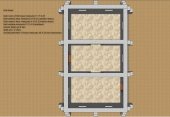


Chris Sturgeon wrote:There's a YouTube channel by a couple who moved up to Alaska to homestead. They had a market garden in Oregon but are learning about the different environment they are in now.
They built an underground earthbag cellar last Summer, successfully used it for a Winter... and in their last video they are filling it in with gravel.
I feel that one of the reasons why their experiment failed was because of the shape of the walls. Round would have been better. Domed would have been bombproof.
https://www.youtube.com/watch?v=Ss2AaCHHNpc
Tina Tex wrote:Hi, I am building a 180 sq ft EB shed into the side of a hill. I filled all of my bags first, as I dug out the hill, and then learned about hard-assing in the Kaki Hunter book EB tricks and tips. I am wondering how important this technique is if you have good fill? Also, I'd like to hear opinions on diddling the bags (no funny stuff here people, diddling refers to tucking in the pointy ends). I can still diddle the bags post hoc, but that will get old and would like to avoid it if I can. And remember, this is a shed, not my house. Yes, I would like to build as well as I can always, but maybe these techniques are not critical in my case?
Thanks for your thoughts!

Ronny Björling wrote:Hi!
Now when some years has past, how is it doing?
I'm planning to build one my self. But when I spoke to the manufacturer of the bags, they said that the bags won't last past 6 months. For me it sound weird.
It's poly bags so..
Ronny from Sweden
 but in the end you will have a house that will stand up to anything.
but in the end you will have a house that will stand up to anything.


